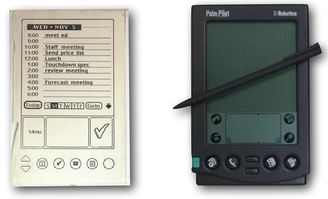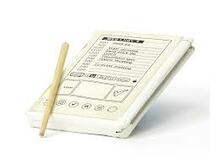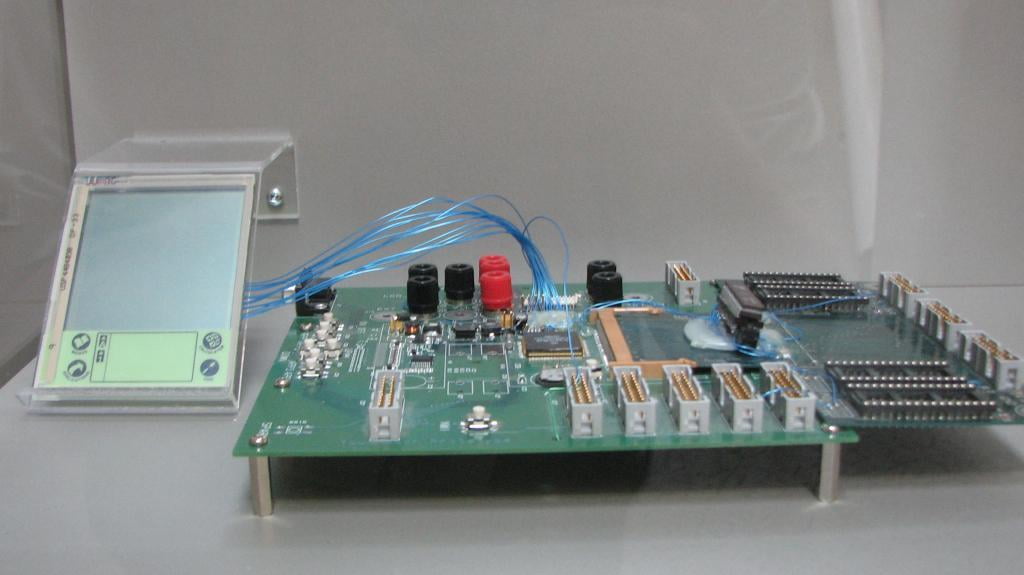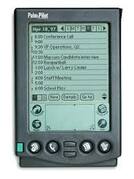What is pretotyping?

The best way to explain pretotyping is through examples, so let's look at one. On the left is a pretotype of the Palm Pilot next to the final product.
The founder of Palm Computing, Jeff Hawkins, mocked up a Palm Pilot with wood and paper; then carried it with him for weeks pretending it was a working device. His objective was to learn if he would actually use such a device before going to the next, very expensive and time-consuming step, of building an actual working prototype.
Even though Hawkins did not use the term pretotyping (because we hadn't made it up yet) that's exactly what he was doing; simulating the core experience of having and using a Palm Pilot with the smallest possible investment of time and money to see if he would actually carry and use it.
Pretotyping differs from prototyping in one important respect:
The main objective of prototyping is to answer questions related to building the product. Can we build it? Will it work as expected? How cheaply can we build it? How fast can we make it?
The main objective of pretotyping is to answer questions about the product's appeal and usage. Would people be interested in it? Will they use it as expected? Will they continue to use it? ...
Below are the Palm pretotype, prototype and product side-by-side. Notice the dramatic difference between pretotypes and prototypes?
(Here's a video with more details on the Palm Pilot example and how pretotyping differs from prototyping.)
The founder of Palm Computing, Jeff Hawkins, mocked up a Palm Pilot with wood and paper; then carried it with him for weeks pretending it was a working device. His objective was to learn if he would actually use such a device before going to the next, very expensive and time-consuming step, of building an actual working prototype.
Even though Hawkins did not use the term pretotyping (because we hadn't made it up yet) that's exactly what he was doing; simulating the core experience of having and using a Palm Pilot with the smallest possible investment of time and money to see if he would actually carry and use it.
Pretotyping differs from prototyping in one important respect:
The main objective of prototyping is to answer questions related to building the product. Can we build it? Will it work as expected? How cheaply can we build it? How fast can we make it?
The main objective of pretotyping is to answer questions about the product's appeal and usage. Would people be interested in it? Will they use it as expected? Will they continue to use it? ...
Below are the Palm pretotype, prototype and product side-by-side. Notice the dramatic difference between pretotypes and prototypes?
(Here's a video with more details on the Palm Pilot example and how pretotyping differs from prototyping.)
(Here's a video with more details on the Palm Pilot example and how pretotyping differs from prototyping.)
Apply the methodology
|
Step 1: Isolate the Key Assumption
What is the one assumption about your idea that, if false, means it's definitely not the right it? Step 2: Choose a Type of Pretotype What type of pretotype will let you to isolate and test your key assumption? Quick Guide to Pretotype Types Step 3: Make a Market Engagement Hypothesis How many (and what kind of) people will do what with your pretotype? Your hypothesis can be as simple as: X% of Y will do Z A solid hypothesis takes the guesswork and opinion out of testing. Step 4: Test Your Pretotype Now put your pretotype into the real world, and see how people interact with it. Start small — one place, one time. Step 5:Learn, Refine, Hypozoom Evaluate your results. Refine your pretotype with your new data. If you hypothesis held, decide what other situations you should test your pretotype in to get a complete picture (what we call "hypozooming"). |


